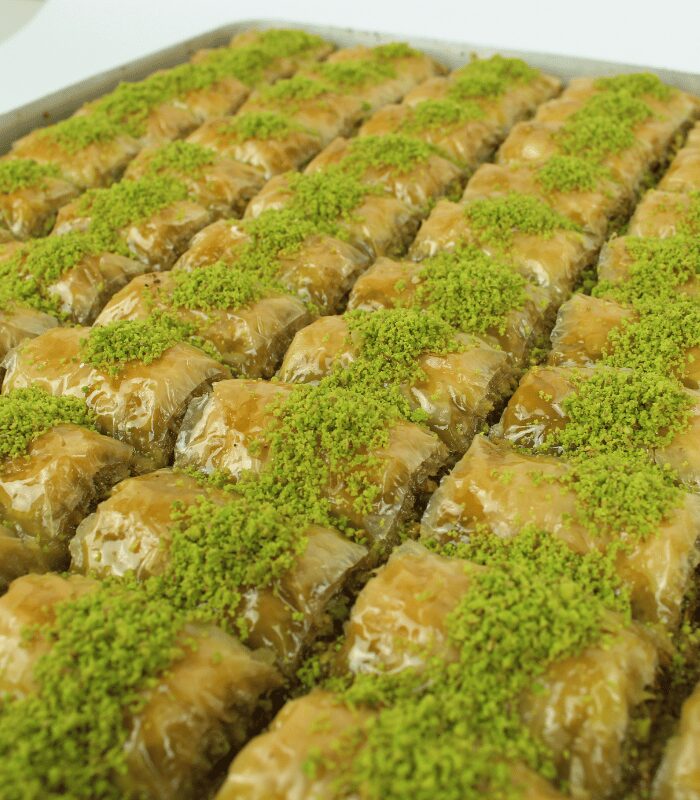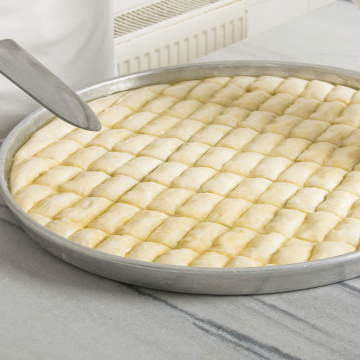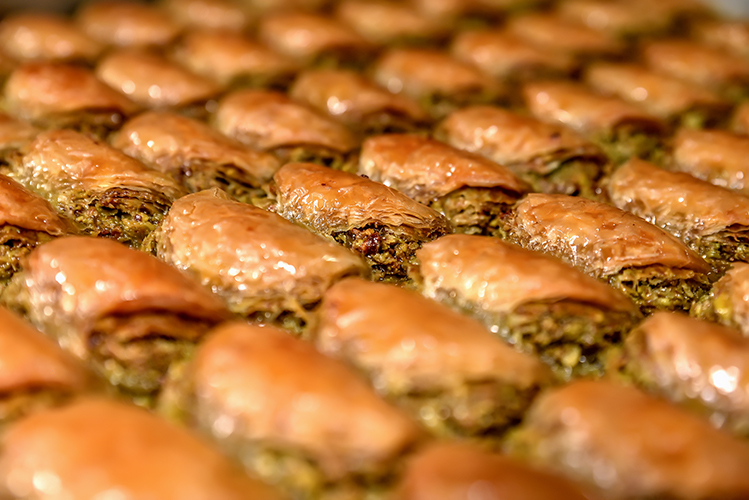Die Geschichte der Baklava: Eine süße Reise durch die Zeit
Baklava ist nicht nur eine beliebte Süßspeise, sondern trägt eine reiche und vielfältige Geschichte in sich. Die Wurzeln dieser delikaten Köstlichkeit reichen über 2.000 Jahre zurück, bis in die Zeit der alten Mesopotamier und Assyrer. Die ersten Formen von Baklava wurden als dünne Teigschichten beschrieben, die mit Nüssen gefüllt und mit Honig überzogen wurden.
Mit der Expansion des Osmanischen Reiches im 15. Jahrhundert verbreitete sich Baklava und wurde fester Bestandteil der Hofküche. Die Sultanen genossen diese süße Leckerei besonders während der Ramadan-Feiern. In dieser Zeit erlangte Baklava eine herausragende Stellung in der osmanischen Küche und wurde als Zeichen des Wohlstands und der Gastfreundschaft angesehen.
Heutzutage hat Baklava seinen Weg in viele Länder gefunden, vor allem in den Mittelmeerraum und darüber hinaus. Jede Region hat ihre eigene Variante entwickelt: Die griechische Baklava enthält oft Walnüsse, während die türkische Version häufig Pistazien verwendet. Trotz dieser regionalen Unterschiede bleibt eines konstant – die Kunstfertigkeit, die in jede Schicht des Teigs und der Füllung einfließt, um das perfekte Gleichgewicht zwischen Süße und Knusprigkeit zu schaffen.

Die Herstellung von Baklava
Das Geheimnis von perfektem Baklava liegt in der traditionellen Handwerkskunst. Jede Teigschicht wird hauchdünn ausgerollt, manchmal bis zu 40 Schichten. Zwischen den Schichten werden großzügig Nüsse – typischerweise Pistazien oder Walnüsse – verteilt, bevor alles mit Sirup oder Honig getränkt wird.
Besonders in der Türkei hat sich Baklava zu einem kulturellen Symbol entwickelt. Bei Festen, Hochzeiten und Feiertagen darf Baklava nicht fehlen. In den besten Konditoreien, wie bei Baklavacı Anteplioğulları, wird Baklava nach jahrhundertealten Rezepten hergestellt, die von Generation zu Generation weitergegeben wurden. Hier steht Handarbeit und Qualität im Vordergrund, um den authentischen Geschmack zu bewahren.

Baklava weltweit
Baklava hat in vielen Ländern eine Heimat gefunden und wird dort in unterschiedlichsten Formen und Rezepturen genossen. In Griechenland, dem Libanon, Armenien und sogar in Teilen Osteuropas findet man verschiedene Baklava-Varianten. Doch egal, wo Baklava genossen wird, es bleibt eine Süßspeise, die Genuss, Tradition und Kultur miteinander verbindet.
Fazit
Baklava ist mehr als nur eine Süßspeise. Es ist ein Stück Geschichte, das die Jahrhunderte überdauert hat, und weiterhin Menschen weltweit begeistert. Von seinen Anfängen im antiken Mesopotamien bis zu seiner modernen Form, die wir heute kennen und lieben, bleibt Baklava ein Symbol für Tradition, Handwerkskunst und puren Genuss.
Die Geschichte der Baklava: Eine süße Reise durch die Zeit
Baklava ist nicht nur ein köstliches Dessert, sondern trägt eine jahrtausendealte Geschichte in sich. Diese süße Delikatesse hat ihre Ursprünge im antiken Mesopotamien, wo die ersten Formen von Gebäck mit Nüssen und Honig zubereitet wurden. Von dort aus verbreitete sich das Rezept über den gesamten Nahen Osten und den Mittelmeerraum. Über die Jahrhunderte wurde Baklava verfeinert, insbesondere während des Osmanischen Reichs, wo es eine beliebte Speise bei den Sultanen war. Diese führten Baklava in ihre Bankette ein und es wurde bald zu einem Symbol für Gastfreundschaft und Wohlstand. Die Zubereitung von Baklava entwickelte sich zu einer hohen Kunstform, wobei bis zu 40 Teigschichten verwendet wurden, um die perfekte Balance aus Knusprigkeit und Süße zu schaffen.
Ein Fest für die Sinne
Baklava ist mehr als nur ein Dessert – es ist ein Fest für die Sinne. Der Duft von gerösteten Nüssen und süßem Sirup steigt in die Nase, bevor der erste Bissen die perfekte Kombination aus knusprigem Teig und saftiger Füllung offenbart. Jede Region hat ihre eigene Interpretation von Baklava entwickelt. Während in der Türkei oft Pistazien verwendet werden, bevorzugen andere Länder Walnüsse oder Mandeln. Was jedoch in allen Regionen gleich bleibt, ist die Liebe zum Detail bei der Herstellung.
Die Rolle der Baklava in der türkischen Kultur
In der Türkei wird Baklava besonders zu festlichen Anlässen serviert. Es ist ein fester Bestandteil des Ramadan und wird oft nach dem Fastenbrechen gegessen. Auch bei Hochzeiten und besonderen Familienfeiern darf Baklava nicht fehlen. Jede Familie hat oft ihr eigenes Rezept, das über Generationen weitergegeben wird. In der Türkei gibt es sogar den sogenannten „Baklava-Zug“, bei dem Tabletts voller Baklava während der Feiertage an Freunde und Familie verschenkt werden.
Modernes Baklava: Tradition trifft auf Innovation
Auch wenn Baklava seit Jahrhunderten auf traditionelle Weise hergestellt wird, gibt es heute moderne Varianten, die den klassischen Geschmack mit neuen Zutaten und Formen kombinieren. Schokoladen-Baklava, vegane Versionen und kreative Füllungen sind nur einige Beispiele, wie Baklava in der modernen Küche neu interpretiert wird. Trotz dieser Innovationen bleibt die klassische Pistazien-Baklava eine unangefochtene Lieblingssüßigkeit in vielen Ländern.
Schlussgedanken
Ob als traditionelles Dessert auf Festen oder als süße Versuchung zwischendurch – Baklava bleibt ein unvergessliches Geschmackserlebnis, das Geschichte und Genuss perfekt vereint. Bei Baklavacı Anteplioğulları bleibt das traditionelle Handwerk der Baklava-Herstellung lebendig, mit sorgfältig ausgewählten Zutaten und viel Liebe zum Detail. Probieren Sie unsere köstliche Baklava und genießen Sie ein Stück Geschichte.
https://www.einfachbacken.de/rezepte/baklava-ganz-das-beste-rezept-zum-selber-machen

